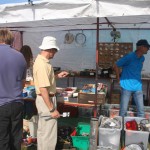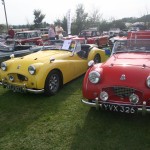It’s Saturday 27 September and the forecast is for a warm dry weekend; it certainly looks promising as we erect the club gazebo for the last show of the season. The promise is honoured on the Sunday as we arrive at the show in glorious sunshine, a last hurrah and farewell to the Indian summer that we have enjoyed during one of the driest Septembers in recent times.
The turn-out, as with the weather, does not disappoint. A total of twenty four cars grace our stand, with only one no show. It’s good to see a splendid selection of “moderns”, including: four XJ-S’s, an equal number of XK8’s, two XKR’s, two X300’s, and XJ8 358’s, one 308, an S type and a new F Type Coupe, courtesy of Grange Motors. The older classics seem to have come in pairs with a brace of 420’s, two Mark II’s, twin Daimler 250’s and a couple of E Types. Bucking the trend are a Daimler XJ6 and a 420G. Thanks to all the members who attended and made it a perfect day.
The fine day also brings out a large and varied selection of auto-jumblers and other associated traders. New old stock parts for fifties British family saloons, tools (old and new), reconditioned transistor radios, cycle helmets, leather coats, paint, polish and, most surprising of all, a novelty Starship Enterprise telephone – I am tempted by that one – are all there to be found new owners. I don’t come away empty handed, however, since I splash out on three packs of assorted jubilee clips, a roll of cleaning cloth and a Hilka magnetic tray for nuts and bolts – after I saw Ed China using one on Wheeler Dealers.
The wares of the stalls are not the only gems to be discovered in the show. A short walk from the Club Stand reveals several British Car Clubs, with gatherings of Triumph TR’s, Spitfires and Vitesse’s, the Austin Seven Club (celebrating its 40th anniversary), the Mini Club, the Escort Club and, continuing the Ford theme, the ’56 to ’62 Consul, Zephyr, Zodiac Club. All good contenders for the Best Club Stand Prize (after us, of course). I don’t know who won, but all there deserved a prize.
Over in the field, as always, there is an eclectic mix of vehicles, all displayed to the highest of standards and an entertaining walk could be had amongst the rows of these cherished transport icons. Whilst you could see most examples of fifties and sixties British fare, all beautifully presented – I owned a few in my youth – it is the Americana, dripping with chrome and inspiring nostalgia for the early to mid- decades of the last century, which draw this writer in to see more.
Representing the forties is a lovely maroon Lincoln Zephyr and a blue Chevrolet Coupe, plus many more, while the Fifties are recalled by several Chevy Pick Ups (becoming very popular and expensive), Cadillacs – don’t you just love those fins? – Buicks and Oldsmobiles. A rare beast parked amongst the Bel Airs is the Nomad Estate (Station Wagon) which is a three door model. A Desoto Fireflite displays even bigger fins than the Caddy’s, a couple of gorgeous Corvettes and a lovely first series ‘55 Thunderbird also catches my eye.
The two cars that must be mentioned from the sixties are the Bullitt Ford Mustang and Dodge Charger. Both immaculate and faithful replicas of those in the film, right down to the registration plates. The Charger comes with a pump action shotgun on the passenger seat, whilst the Mustang’s is adorned by Bullitt’s shoulder holster and gun. All fakes, I trust. The best accessory is behind the wheel of the Mustang, a very lifelike dummy of Steve McQueen!
The rarest car in the show comes from the Roaring Twenties – a Marmon (I think a Model 78, but I may be corrected). Finished in green (a 1961 re-spray) with brown cloth interior that is original, except that it started out grey until years of nicotine had their effect.
For those who have never heard of the make, Marmon made grain elevators as Nordyke and Marmon in Indianapolis and was founded in 1851. By 1902 they had made their first car, a V Twin with some very advanced features for the day. By 1911, they were well into car production and won the first Indianapolis 500 in a Type 32, known as the Wasp because of its colour scheme. The circuit was initially built as a test track for automobiles and as a speedway for local entertainment. Although the cars were known for solid and advanced engineering, at the prestige end of the spectrum, and sold relatively well, they did not keep up with the times, and when they did, it was too late. That, together with the Great Depression, saw them calling in the receivers in 1933, with a little over 100,000 cars built over the company’s car production lifetime. The Battlesbridge car is thought to be one of only two right hand drive models in existence or so the owner says.
Well, that’s it for this report as it may well be for the Battlesbridge Shows. If it is, then at least the potential ultimate gathering has gone out on a high.
Neil Shanley
[youtube=http://youtu.be/ltOfqFeyz9c]

















